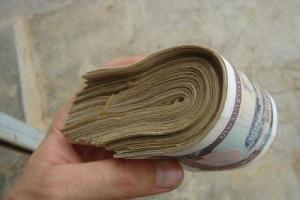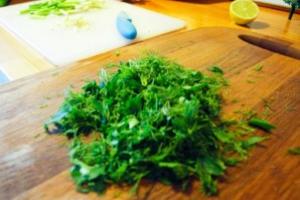

Materials and tools:
Polyurethane foam (any)
Glue "Titan"
Wood putty.
Acrylic paints.
Liquid nails “Fix All” (Cristal)
Toothpicks
Brush
Acrylic paints
Acrylate wood varnish
Small decorative stones.
Film
Gloves
A stationery (or any convenient) knife.
Plastic covers for notebooks.
I love waterfalls and I love looking at them and trying to draw them, but here I really wanted a home waterfall. But not the one where water flows (for some reason this is annoying...), but the most ordinary one.
I tried to film and describe the process of creating a home waterfall.
Take polyurethane foam (I took the most common one in a can for 100 rubles).
Lay on work surface oilcloth or film. Be sure to wear gloves
(rubber or medical), because the foam sticks very much to your hands and is difficult to wash off. Foam several “slides” on the film, spray the “slides” with a flower spray so that the foam “sets” faster. Wait until the top of the “slide” dries, remove it from the film (the bottom remains wet) and place the slides on top of each other so as you see your big mountain. Since the bottom has not yet dried, the slides “sit” on top of each other and immediately stick together.
Give the foam a day to “set.”

Cut out the base of the mountain from the resulting mass - cut off the excess from the sides using a knife, cut through caves and recesses.
Treat all surfaces and joints with putty. Let it dry for a day.

Paint the slide, walls and “bottom” of the waterfall first with dark brown, then light brown paint. Give the paint time to dry.


Spread the “Titanium” glue on the surface of the “mountain”, sprinkling the glue with small decorative pebbles. Cover with acrylic varnish. Dry overnight.
Paint the “bottom” of the waterfall and the places where the “water” flows with blue and white paints.


To simulate flowing water, the following was tested:
1. Liquid nails “Moment” Installation transparent..
The photo shows “transparency”, yeah. as they were opaque white, they remained so even after two days..

2. Liquid nails “AXTON” transparent. I didn’t like it, first of all, it had a very pungent, poisonous smell (as if a lot, a lot of vinegar had been mixed with something). So, the resulting “waterfalls” are a bit cloudy and ugly, a disgrace.

3. Liquid nails “Fix-All soludal, Crystal/ You can try others, but the word Crystal must be present.. Nails are expensive (we cost 370 rubles, but when you have the urge to do it, you can’t bear it..)

Take a napkin and make a “stencil” of the required length.

I bought a regular notebook cover for the imitation water backing. It is transparent with blue and this turned out to be just it.

Having prepared the stencils, place the cover on them.

Take liquid nails and “draw” stripes on the stencil with them, close to each other. Using a toothpick, smooth the surface of the strips with a zigzag line.

Leave to dry. But it’s better to leave it to dry like that. so that the dried nails can be accepted the required form. Cut the film along the contour of the waterfall, use a toothpick to pierce the film at the beginning of the “waterfall” and attach it to a convenient, convex surface.

After allowing time for the “flowing water” to dry, use the same nails to coat the recesses in the “mountain” and attach the workpieces with a toothpick. Correct the “waterfalls” by adding strips of liquid nails, simulating the effect of flowing water.


Paint the surface of the waterfall with an almost dry white brush and white paint.

Wait for the “waterfalls” to dry completely and check that everything corresponds to what you planned. Place several decorative elements on the bottom, in my case these are white round decorative stones. In “liquid glass”, poured into any container that you don’t mind throwing away, add any blue dye (in this case I took soap dye) - 3-4 drops


Allow time to dry completely" liquid glass", depending on the thickness of the layer, this will range from two to four days.
 Add a couple of strips of “liquid nails” at the base of the “waterfalls”, mix the applied strips with the dried “water”. Using a toothpick or bamboo stick, lift the sealant at the base of the “waterfall” with small sharp “waves”
Add a couple of strips of “liquid nails” at the base of the “waterfalls”, mix the applied strips with the dried “water”. Using a toothpick or bamboo stick, lift the sealant at the base of the “waterfall” with small sharp “waves”

Allow time to dry and paint the ends of the “waves” at the base of the waterfall with white paint.

That's it, the waterfall is ready...



Materials and tools:
Polyurethane foam (any)
Glue "Titan"
Wood putty.
Acrylic paints.
Liquid nails “Fix All” (Cristal)
Toothpicks
Brush
Acrylic paints
Acrylate wood varnish
Small decorative stones.
Film
Gloves
A stationery (or any convenient) knife.
Plastic covers for notebooks.
I love waterfalls and I love looking at them and trying to draw them, but here I really wanted a home waterfall. But not the one where water flows (for some reason this is annoying...), but the most ordinary one.
I tried to film and describe the process of creating a home waterfall.
Take polyurethane foam (I took the most common one in a can for 100 rubles).
Place oilcloth or film on the work surface. Be sure to wear gloves
(rubber or medical), because the foam sticks very much to your hands and is difficult to wash off. Foam several “slides” on the film, spray the “slides” with a flower spray so that the foam “sets” faster. Wait until the top of the “slide” dries, remove it from the film (the bottom remains wet) and place the slides on top of each other so as you see your big mountain. Since the bottom has not yet dried, the slides “sit” on top of each other and immediately stick together.
Give the foam a day to “set.”

Cut out the base of the mountain from the resulting mass - cut off the excess from the sides using a knife, cut through caves and recesses.
Treat all surfaces and joints with putty. Let it dry for a day.

Paint the slide, walls and “bottom” of the waterfall first with dark brown, then light brown paint. Give the paint time to dry.


Spread the “Titanium” glue on the surface of the “mountain”, sprinkling the glue with small decorative pebbles. Cover with acrylic varnish. Dry overnight.
Paint the “bottom” of the waterfall and the places where the “water” flows with blue and white paints.


To simulate flowing water, the following was tested:
1. Liquid nails “Moment” Installation transparent..
The photo shows “transparency”, yeah. as they were opaque white, they remained so even after two days..

2. Liquid nails “AXTON” transparent. I didn’t like it, first of all, it had a very pungent, poisonous smell (as if a lot, a lot of vinegar had been mixed with something). So, the resulting “waterfalls” are a bit cloudy and ugly, a disgrace.

3. Liquid nails “Fix-All soludal, Crystal/ You can try others, but the word Crystal must be present.. Nails are expensive (we cost 370 rubles, but when you have the urge to do it, you can’t bear it..)

Take a napkin and make a “stencil” of the required length.

I bought a regular notebook cover for the imitation water backing. It is transparent with blue and this turned out to be just it.

Having prepared the stencils, place the cover on them.

Take liquid nails and “draw” stripes on the stencil with them, close to each other. Using a toothpick, smooth the surface of the strips with a zigzag line.

Leave to dry. But it’s better to leave it to dry like that. so that the dried nails take the desired shape. Cut the film along the contour of the waterfall, use a toothpick to pierce the film at the beginning of the “waterfall” and attach it to a convenient, convex surface.

After allowing time for the “flowing water” to dry, use the same nails to coat the recesses in the “mountain” and attach the workpieces with a toothpick. Correct the “waterfalls” by adding strips of liquid nails, simulating the effect of flowing water.


Paint the surface of the waterfall with an almost dry white brush and white paint.

Wait for the “waterfalls” to dry completely and check that everything corresponds to what you planned. Place several decorative elements on the bottom, in my case these are white round decorative stones. In “liquid glass”, poured into any container that you don’t mind throwing away, add any blue dye (in this case I took soap dye) - 3-4 drops


Allow time for the “liquid glass” to dry completely; depending on the thickness of the layer, this will take from two to four days.
 Add a couple of strips of “liquid nails” at the base of the “waterfalls”, mix the applied strips with the dried “water”. Using a toothpick or bamboo stick, lift the sealant at the base of the “waterfall” with small sharp “waves”
Add a couple of strips of “liquid nails” at the base of the “waterfalls”, mix the applied strips with the dried “water”. Using a toothpick or bamboo stick, lift the sealant at the base of the “waterfall” with small sharp “waves”

Allow time to dry and paint the ends of the “waves” at the base of the waterfall with white paint.

That's it, the waterfall is ready...
Reducing indoor air humidity is a side effect of heating an apartment in winter. Moreover, excessively dry air not only causes discomfort when breathing, but also causes an increase in the number of colds.
The dry mucous membrane of the nasopharynx becomes more susceptible to all kinds of infections and viruses. That is why during heating season You should consider humidifying the air.On sale you can find many different devices for air humidification: evaporator, steam generator, humidifier, etc. Some owners simply place an open bowl of water in the room. As you can see, there are many options, but none of them are suitable for creative people, since our imagination simply cannot accept this simple solution. After all, there is an opportunity to do something very useful and most importantly beautiful thing, with your own hands. So, after thinking a little, we found a way out of the situation by inviting you, dear readers, to do indoor fountain. You can install this beauty in any convenient location: on the floor, on the table, on a stand. A decorative fountain will be an excellent interior decoration and will fit perfectly into any style. Moreover, the murmuring water of an indoor waterfall creates a peaceful environment conducive to rest and relaxation.
Master Class tabletop waterfall. DIY tabletop fountain.
To make a tabletop waterfall-fountain craft, we first of all need a mini pump for (water circulation in the fountain) lifting water from the lower reservoir to the upper reservoir. It is best to use a pump water pump, which you can simply put in the lower reservoir (pond) and pump water up. Unfortunately, we do not have such pumps for sale, therefore, in this master class, we use a water pump from household appliances, or rather from an electric samovar (photo below).

The lower reservoir reservoir is made from plastic bottle from under oil (5 l). Cut off the lower part with a height of 5-8cm.

A round cake tray with a diameter of 29-30 cm is used as a base. You can use any shallow plastic container.
Connection of the pump to the lower reservoir. Using a hot soldering iron, make a hole in the bottom reservoir. The hole should be 0.5mm smaller than the diameter of the pump tube. This is necessary to ensure that the connection to the pump is tight, which will avoid leakage. If you cannot tightly connect the pump to the reservoir, you can proceed as follows: put a piece of soft hose on the pump tube and thread it into the prepared hole, which will seal the connection (see photo below).


At this step you can check the operation of our fountain. Also check if there is a leak somewhere.
The above steps are only necessary if you do not have a pump pump.
Relief production. To make the relief we will use construction foam. Cover the entire base with foam to a height of 5-6cm. Wait for the first layer to harden. This will take approximately 3-4 hours and start building up the slide (base of the waterfall) (see photo below). We gradually increase the base of the waterfall by 15-17cm.

After the foam has completely hardened (after 10-12 hours), we begin creating a waterfall. We cover the bed of the waterfall with pebbles and place a small lake on top. After completing the formation of the waterfall, we coat the bed well and, especially carefully, the seams between the pebbles with waterproof glue and liquid nails (see photo above).

After the glue has dried, we check the operation of our tabletop fountain - waterfall. It will not be possible to get a beautiful drop of water right away, therefore, using a gun (hot glue), we form 3-4 nests in which streams of water will form and fall down, see photo above.

Pour PVA construction adhesive diluted 1:1 with water into a container, add color and sand. Stir and add sand until it reaches a creamy consistency. Let's prepare several shades of green and paint our craft, applying each layer after the previous one has dried.

The result of painting a decorative fountain is shown in the photo above.
Let's start making the base (pallet) for our tabletop waterfall - fountain craft.

From thick sheet cardboard we cut out a circle with a diameter of 30 cm, and another circle with an internal diameter of 30 cm and an external diameter of 32 cm, strips 5 and 1.5 centimeters wide. Glue all the parts as shown in the photos above.


We install our waterfall on the base and proceed to the final stage.
In between working on the tabletop waterfall, I assembled a sequin tree on the stone.

We glue the tree into a previously prepared place and complete the work on the tabletop fountain - waterfall, covering all the flaws and minor shortcomings.

So I'm ready original craft. Looking at her, you would never think that you can create such beauty with your own hands and use available materials for this. This indoor fountain will make everyone happy. What's not an idea for a great gift?!

It would seem that when we offered you to make a fountain for your home, we were thinking about humidifying the air in the room, but in the end we not only solved this problem, but also brought a touch of originality and sophistication to your home.

A tabletop waterfall or floating cup will become decor for an aquarium or room. On your garden plot you can make a waterfall in your dacha.
The content of the article:
A waterfall allows you to transform a corner of your apartment or summer cottage into natural. It’s nice to watch a man-made stream running and listen to its murmur. If you do not have a summer cottage, but have an aquarium, then knowledge on how to make a waterfall in it will be useful to you. Those who have their own hacienda can still first practice creating a small device, and then make a waterfall in the country.
Decorative waterfall for an aquarium
It’s not for nothing that this subtitle has such a name, because a home stream is worthy decoration aquarium
Look at the principle of construction of such a waterfall. As you can see, it consists of simple objects. Due to the circulation of transparent and fine white sand, which drives the compressor, a very interesting effect is created.

To make this decor for an aquarium with your own hands, you will need:
- plastic bottle - volume 1.5 liters;
- dropper;
- plastic bottle - volume 0.5 liters;
- silicone sealant;
- plastic water pipe diameter 370 mm;
- water rubber hose diameter 120–300 mm;
- narrow tape;
- compressor;

Using sealant, glue the hose to the tube. Step back 3 cm from the bottom of the hose, use a sharp knife to make an oval-shaped cut 2 cm deep and 1 cm wide.
It was the turn of the 1.5 liter bottle. Cut off the threaded neck from it, then the next part just below the shoulders. You've got a kind of bowl. Place it on the rubber tube, securing it at the cut site.

Next, you need to bend the 3 ends of the plastic water pipe, fix them in this position with tape, winding it.

Now you need to carefully seal the joint between the hoses and the bowl with sealant, then step away from work and wait for the solution to dry completely. After this, you can proceed to the next stage. At the top of the hose, make an oval diagonal cut, 2.5 cm deep and 1 cm wide.

Glue the plastic tip from the dropper to the bottom of the tube; you need to be patient and wait for the solution to dry completely.

Only after this can the tube from the dropper be placed on the plastic tip, and the other edge of the tube must be connected to the compressor.

At this stage, you need to check if everything is working correctly by turning on the compressor. If you are satisfied, let's continue creating. To make a visor cap, you need to cut off the top of a 500 ml plastic bottle and remove the neck using a knife. You should end up with a funnel 3 cm high.

Make a cut on the side, attach this element to the top using sealant and narrow tape.
Please note that the visor from a small plastic bottle should not cover the upper section of the hose; air bubbles will subsequently escape through this hole.

All that remains is to decorate the waterfall by attaching pebbles to it using sealant. This is what you get.

To make your aquarium decor in the form of flowing sand make a lasting impression, you can purchase colored artificial sand. If this fails, choose a regular fraction so that it is not too small or large. In the first case, it will become too dispersed in different directions, and in the second, grains of sand can create a traffic jam and make it difficult for the waterfall to work.
DIY small stone stream at home
Check out another way to make a waterfall. This is how it might turn out as a result.

To do this you need to get this:
- small stones;
- sand;
- a platform, which could well be the lid of a small plastic bucket or even a jar of herring, a plastic saucer;
- tile adhesive;
- liquid nails “Fix All” or Titan glue;
- a small decorative jug;
- knitting needle;
- tile adhesive.

It is not necessary to buy stones; if you go for a walk in the snowy season, watch your step. Sometimes you can find very beautiful specimens near the road or path. After you come home, wash them well, lay them out on a towel to dry, and at this time move on to another stage of the work.
Apply glue to the lid, sprinkle it with sand so that it sticks here. In this case, it is necessary to design not only the upper part of the lid, but also its rim.
If you use, for example, a plastic saucer, then its sides do not need to be covered. Bring glue over the sand and attach pebbles here. From the larger ones, make something like a rock. Place a small decorative jug on top, attaching it in the same way.

Let the tile adhesive dry, then pour Titanium adhesive into it. Pour it into the jug and wait 10 minutes. This is necessary for him to “grab it.” By winding its hardening fibers onto a knitting needle, give the waterfall the desired shape.
If you are using liquid nails, then first cut out a water pattern from paper, then cover it with this mass, wait until it dries. Then you can attach the falling water to the top of the work.

It seems as if it really is water, and the air bubbles give the work greater authenticity.
If you brought shells from the sea, then use them for your craft. Look at how to place them and where to attach the artificial greenery. Liquid nails or glue will create the impression of falling water.

If you don't have sand, then make the base of a waterfall with clear blue water. Place a cut piece of oilcloth or other rubberized material of the same color on the selected round container. Fill the top with glue, which will soon create the effect of an exotic lake.

If you want to make a rock for a waterfall, then take for this:
- polyurethane foam;
- sharp construction knife;
- acrylic paints;
- Titan glue;
- sand.

Now paint it with light brown paints, leaving free space where the streams will flow. Fill these places with blue paint. Glue sand onto some areas of the rock after the paint has dried. When the glue is completely dry, then you need to make falling water from liquid nails or Titanium, and another tabletop waterfall is ready.

Place a gold one next to it to create a nautical-themed corner in your home.
If you have suburban area, then there will certainly be a place to create a waterfall here. Here you can have a wonderful rest and enjoy the babbling of a man-made stream.
How to make a waterfall in your country house?
Step-by-step instructions and photo illustrations will help you understand the principle of its structure. A list of what you need will make the task easier self-selection information. To make this work use:
- sand;
- pebbles;
- quartzite;
- cement;
- granotsev;
- PVC film or fiberglass;
- reinforcing mesh;
- water pump;
- rubber hose.

Now you can pick up a shovel and dig a pit. But since you will be making a waterfall in your dacha, you need to build a hill. You will create it from dug up earth. To strengthen this slide and create a cascade, design it the way the brave altruists do in the photo.

Make a pit of sufficient depth. If you want to subsequently breed fish there, then it should be at least a meter wide so that the water does not freeze in winter.
When constructing a recess, keep in mind that it will need to be filled with 10 centimeters of sand. It is spilled and compacted. Now you can lay waterproofing from the material of your choice on top.

There should be enough film so that it extends well onto the banks. Press her down here with rocks. When digging a pit, you need to make another small depression where you will place the polyethylene pipe.
If you want the lower part of the waterfall to have a strong film that won’t tear, then place a reinforcing mesh here and place a concrete solution 12–15 cm high on top. Let the bowl of the lake dry thoroughly.
Now look at how the water system will be arranged.

As you can see, there is a pump at the bottom, the cable and hose are brought to the surface. The cable will be connected to the network, the hose will need to be laid between the stones of the slide so that the water can rise and then flow down.
To do this, lay flat sandstone and pebbles in the form of a slide. This is what a beautiful cascading waterfall turns out to be.

If you don’t want to lay a film on the bottom of the trench or concrete the bowl, then use a ready-made container for ponds.
But first, you will also have to dig a ditch, then place a bowl here, and cover the junction of the reservoir with the soil from the outside with the excavated earth in order to close the boundaries of the lake.

Also place a pump here, connect a hose to it, the upper edge of which must be raised to a sufficient height, draped with stones to create a waterfall. You can put a garden fountain, it will turn out to be a very nice pond.

You can put it here aquatic plants in plastic pots. If you want, turn this place into alpine slide, combining stones with unpretentious mountain vegetation, then the principle of creation can be the same as in the next photo.

You will certainly find the following diagram useful, which shows in detail what an artificial waterfall consists of.

DIY floating cup
If the previous work seemed difficult to you, see how to make a waterfall so that it is in the apartment. Moreover, looking at some samples, you will see not only flowing water, but also floating flowers and even delicious chocolate and coffee icing that will pour out of the container onto a piece of cake.
Let's continue the topic we started, let's see how to create a floating cup with your own hands, from which an inexhaustible stream of water seems to flow.

To create such beauty, you will need:
- plate;
- transparent plastic bottle;
- cup;
- Titan glue;
- scissors.

Now, one by one, bring these parts to the burner flame to give this interesting shape. There should be flat petals left at the top and bottom, which will then need to be glued to the cup and plate.

To do this, generously coat half of the bottle with Titan glue and glue it to the inside of the cup. Decorate the other half of the plastic bottle in the same way and glue it to the outside of the cup.
Now you need to fix the workpiece in the desired position using auxiliary objects so that it dries completely within two days. This is what happens.

Now you need to coat the plastic bottle blanks again with Titan glue. It’s better to first leave it in the air for 10 minutes, let it become a little thicker. But if there is still a lot of glue in the bubble, then it’s a pity to leave it to dry like that. In this case, you will need to pour Titanium onto the top of the plastic bottle, and lift up what drips down again using a spatula.
If you want the water to have a blue tint, add a little dye of that color to the glue.
Until the solution is completely dry, line the plate with shells and colored pebbles. In the same way, you can decorate the cup itself to create a homemade artificial waterfall.

Not only water can fall from such a container, but flowers can seem to flow out of it.

So that you can put this waterfall on your desktop and admire it, take:
- a coffee pair consisting of a saucer and a cup;
- glue gun;
- thick wire in a winding, length of the segment 20 cm;
- scissors;
- pliers;
- artificial flowers;
- for decoration: butterfly, beads, beads.

From artificial plants, cut off their flowering part, starting from the bottom of the cup; glue them here first.

Next we decorate all the wire and saucer. If you want, you can glue decorations here.

If you want your home to smell deliciously like coffee, use the beans of this tree. But first, it’s better to decorate the mug and cup with jute rope, gluing it to these items in a spiral.
Also connect the coffee pair using a thick wire in a winding, then glue it here coffee beans. Also, cinnamon sticks, which are used to decorate such a fragrant artificial waterfall, would be appropriate here.

Let's develop this delicious topic further. After all, this active flow can fall down, creating a chocolate cake. The first stages of work are similar to the previous master class, so we will not list them again. But you can go into more detail about creating a small cake.
For it you will need polystyrene foam, insulation or something similar. Place a cup-shaped mold here and cut out equal circles. To get a bevel, as if they had already started eating the cake, take a piece with a spoon, you need to cut holes in each, alternating them in size.

Place the workpieces in a stack; if the cut is uneven, correct it at this stage.
The sweetness consists of alternating soufflé and chocolate cakes, to show this, paint the edges of the white blanks black acrylic paint.

Glue the layers together. Then this cake can be covered with putty, sanded or a napkin glued to it. Then the paint will not be absorbed into the porous structure of the material and will lie flat. Apply dark acrylic paint to the sweetness.

Now you need to stick the second end of the wire that fastens the cup into the cake, bend it with reverse side in the form of a loop. To hide this auxiliary attribute, make a recess on the back of the cake and place a piece of wire there.

The cake will be even more appetizing if you cover it with a layer of acrylic varnish and sprinkle on top coconut flakes. If you want the plate to be decorated like in a restaurant, then fill a syringe with brown acrylic paints and draw a line of strokes. Glue the bottom of the wire, which is under the cake, to this plate.

Attach the bottom of the cake to this dish in the same way. Now with the help glue gun or Titan glue should be glued to the flowing waterfall of coffee beans. If you are using a glue gun, be very careful as the silicone coming out of it is hot.

To make a buildable chocolate glaze, spread acrylic lacquer and brown acrylic paint in a one to one ratio. Cover the spaces between the coffee beans and themselves with this substance. When it all dries, you can admire the results of the wonderful work.

Here's how many interesting things you can do with a waterfall theme. If you want to make one at your dacha, then watch the video tutorial. From it you will learn some of the subtleties of the process, for example, you will learn how to glue flat stones.
The second plot will be useful to those who do not have personal plot, but there is a desire to make a waterfall.
The third will reveal the secret of how to make a floating cup with your own hands.
“I saw a lot of tutorials on creating waterfalls from glue. As usual, I took a little from each and created this decoration for the house.”
We need:
- PVA glue ( better professional, but maybe a builder)
- glue TITAN WILD
- dry pharmaceutical herb (I like string or nettle the most, they green color give)
- shells, pebbles, kebab stick
- all sorts of “decorations” - grass, a turtle, small multi-colored pebbles.
- A lot of patience and nerves (later I’ll tell you where you really need them)
Description of making a waterfall
First of all, we “cast” the stand from plaster. Pour gypsum, diluted with water to the consistency of thick sour cream, into the plastic box you like. If you are afraid that it will not stick well, you can grease the mold with a small amount of vegetable oil. After complete drying, paint with acrylic paint. True, then I didn’t like the dark bottom and partially scraped off the paint under the bottom of the reservoir.


Next, I’ll explain my actions a little. I tried to fasten the fountain wall itself with putty, glue, gypsum-adhesive mixture... I didn’t like the result, and in any case, the seams between the stones then need to be decorated with something.
I decided to try my favorite mixture of dry grass and PVA glue. It turned out very similar to moss and the pebbles stuck together perfectly. That's where I stopped. I simply mixed a small amount of glue with dry nettle and cemented the wall with this mixture. Moreover, she was not upset if the neighboring pebbles got dirty during the construction process; moss grows everywhere. She embedded the shells directly into the wall, although it was possible to glue them later.


I laid pebbles on the same mixture along the edge of the reservoir.
After completing the construction of the wall, pour a small amount of Titanium onto the bottom, sprinkle with sand or multi-colored small pebbles, plant grass and decorations.


Now we arm ourselves with a kebab stick and great patience. We take Titanium and begin to quietly pour it into the upper shells. We remember how it flows so that later the waterfall looks natural. You pour and pour, the glue flows down, filling the reservoir and the shells of the cascade.
Stop pouring and the streams of the waterfall “run away” safely. Wind the glue onto a stick in a pond or horizontal shells, pull it up and attach it to the place where the stream should flow out. She runs away, we pull again.... Then a thin stream freezes, we continue to apply layers of glue on it until we get the desired result.
We wait until it dries and add it to the tanks, since the glue shrinks when it dries.
In short, for several days we conjure with glue, a stick and our nerves. The more patient and leisurely you are, the more beautiful the result will be. Bubbles form on their own during the drying process.








